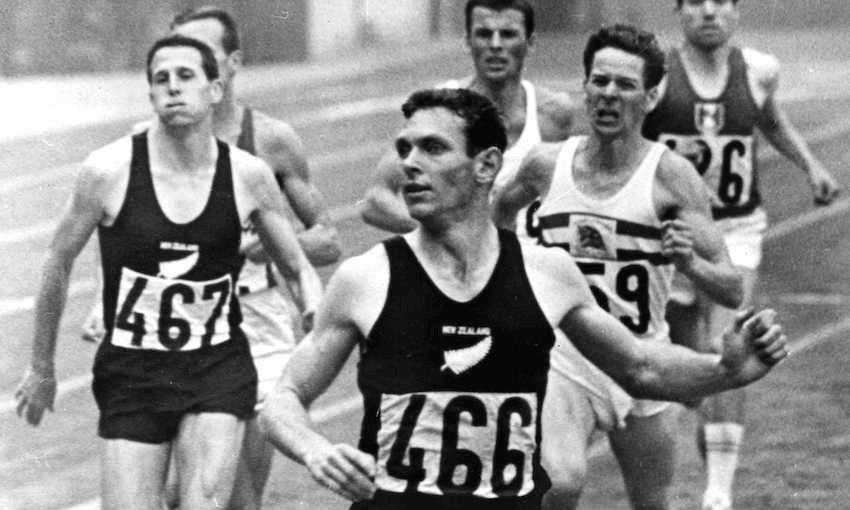Sir Peter Snell has died, aged 80, at his home in Dallas, Texas. James McOnie remembers arguably New Zealand’s greatest ever athlete.
Sir Peter Snell was so great that small towns still engage in custody battles over the legendary runner.
His birthplace Opunake (where he spent his first 11 years) claims him, as does Te Aroha (where he started high school before boarding at Mt Albert Grammar). But then some argue Peter Snell, Olympic Champion was made in West Auckland. Gruff super-coach Arthur Lydiard spotted Snell (who fancied himself more as a tennis player) and asked the teenager to join his running group, who he trained hard in the Waitākere Ranges.
In Snell’s speed, Lydiard knew he had something special, but when the youngster ran the Waiatarua 35km trail he lagged behind the world-class trio of Murray Halberg, Bill Baillie and Barry Magee. One evening, when it was clear Snell wasn’t going to finish the gruelling training run any time soon, Lydiard sent his wife out in their car to pick him up.
The kid came right. As soon as Snell could keep up and finish those endurance runs, he was rewarded with a beer. The great coach told him it contained electrolytes (this checks out, by the way), a story of the young Snell told to me by Lydiard a year or so before he died in 2004.
Three of Lydiard’s runners went to the 1960 Olympics in Rome, and on Friday September 2nd, two of them struck gold. The track had been set alight by the incredible Wilma Rudolph who won the women’s 100 metres (the American sprinter suffered from polio as a child and wore a leg brace until she was 12).
Then Snell took the track in the 800 metres final as a relative unknown. In the home straight, Snell ran from last to first with a blistering finish to win gold. An hour later, Halberg followed with his winning run in the 5,000 metres. To relive that moment (and the toil and turmoil leading up to it), watch the brilliant documentary The Golden Hour.
A week later, Magee would take bronze in the marathon – a race won by barefoot Ethiopian legend Abebe Bikila.
Snell would be the world’s dominant middle-distance runner for the next four years, breaking six world records in different events. Australia’s unbeaten miler and 1500m runner Herb Elliott retired, aged 24, just before the 1962 Empire Games in Perth, his hometown. Some say Elliott knew Snell would be too good. Snell won gold in the 880 yards and the mile at those Games.
Snell went on to the 1964 Tokyo Olympics where he won the 800 metres, and then raced the 1500 metres. Achieving ‘the double’ in the same Olympiad was rare and Snell was worried about the workload of six races in eight days. But he had a rest day before the 1500m final. “That was all I needed,” said Snell.
New Zealand had two runners in that final – Snell and John Davies, from Tokoroa. Davies recalled the moment Snell accelerated, 300 metres from the finish, because cinders and dirt flew up into his face as Snell went past, his shoes tearing up the track as he powered to victory – one of the most emphatic in Olympic history in the 1500 metres.
Another Kiwi, Marise Chamberlain, won bronze in the women’s 800 metres in Tokyo, confirming New Zealand as a global superpower in middle-distance running.
But in 1965, Snell retired from running, aged 26. He worked for tobacco giant Rothmans (!) before moving to America in 1971 to study, getting a science degree in human performance and a PhD in exercise physiology. From 1981, he lived in Dallas, Texas, continuing his research at the University of Texas Southwestern Medical Center.
In later life, Snell competed in orienteering, and he played table tennis at the World Masters Games in Auckland in 2017. He was knighted in 2009.
Whenever I interviewed Snell, I noticed how laidback and humble he was. He’d smile a lot, and never took himself too seriously. And when he was around other athletes from his heyday, he’d blend into the pack, just one of team.
He didn’t want to dwell on his dominance of world athletics or how he may have forced the great Herb Elliott into retirement. His attitude was that these people, including Herb, were his friends and they travelled the world together, competing and putting on a show – and that was a long time ago.
Well Sir Peter, you never wanted to admit it, but you are the G.O.A.T. And you’ve reached the finish line.

